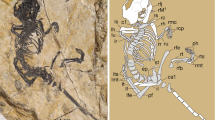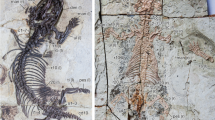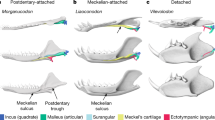Abstract
Detachment of the three tiny middle ear bones from the reptilian mandible is an important innovation of modern mammals. Here we describe a Mesozoic eutriconodont nested within crown mammals that clearly illustrates this transition: the middle ear bones are connected to the mandible via an ossified Meckel’s cartilage. The connected ear and jaw structure is similar to the embryonic pattern in modern monotremes (egg-laying mammals) and placental mammals, but is a paedomorphic feature retained in the adult, unlike in monotreme and placental adults. This suggests that reversal to (or retention of) this premammalian ancestral condition is correlated with different developmental timing (heterochrony) in eutriconodonts. This new eutriconodont adds to the evidence of homoplasy of vertebral characters in the thoraco-lumbar transition and unfused lumbar ribs among early mammals. This is similar to the effect of homeobox gene patterning of vertebrae in modern mammals, making it plausible to extrapolate the effects of Hox gene patterning to account for homoplastic evolution of vertebral characters in early mammals.
This is a preview of subscription content, access via your institution
Access options
Subscribe to this journal
Receive 51 print issues and online access
$199.00 per year
only $3.90 per issue
Buy this article
- Purchase on Springer Link
- Instant access to full article PDF
Prices may be subject to local taxes which are calculated during checkout




Similar content being viewed by others
References
Kielan-Jaworowska, Z. et al. Mammals from the Age of Dinosaurs—Origins, Evolution, and Structure (Columbia Univ. Press, New York, 2004)
Ji, Q. et al. Mesozoic Jehol Biota of Western Liaoning, China (Geol. Publ. House, Beijing, 2004)
Zhou, Z.-H. et al. An exceptionally preserved Lower Cretaceous ecosystem. Nature 421, 807–814 (2003)
Zhang, F. et al. Description of a new enantiornithine bird from the Early Cretaceous of Hebei, northern China. Can. J. Earth Sci. 41, 1097–1107 (2004)
Kermack, K. A. et al. The lower jaw of Morganucodon.. Zool. J. Linn. Soc. (Lond.) 53, 87–175 (1973)
Crompton, A. W. & Luo, Z.-X. in Mammal Phylogeny Vol. 1 (eds Szalay, F. S. et al.) 30–44 (Springer, New York, 1993)
Luo, Z.-X. et al. A new mammaliaform from the Early Jurassic of China and evolution of mammalian characteristics. Science 292, 1535–1540 (2001)
Jenkins, F. A. & Schaff, C. R. The Early Cretaceous mammal Gobiconodon (Mammalia, Triconodonta) from the Cloverly Formation in Montana. J. Vert. Paleontol. 8, 1–24 (1988)
Wang, Y.-Q. et al. An ossified Meckel’s cartilage in two Cretaceous mammals and origin of the mammalian middle ear. Science 294, 357–361 (2001)
Li, C.-K. et al. A new species of Gobiconodon (Triconodonta, Mammalia) and its implication for the age of Jehol Biota. Chin. Sci. Bull. (English edn). 48, 1129–1134 (2003)
Meng, J. et al. The ossified Meckel’s cartilage and internal groove in Mesozoic mammaliaforms: implications to origin of the definitive mammalian middle ear. Zool. J. Linn. Soc. (Lond.) 138, 431–448 (2003)
Hu, Y.-M. et al. Large Mesozoic mammals fed on young dinosaurs. Nature 433, 149–153 (2005)
Ji, Q. et al. A Chinese triconodont mammal and mosaic evolution of the mammalian skeleton. Nature 398, 326–330 (1999)
Luo, Z.-X. et al. Dual origin of tribosphenic mammals. Nature 409, 53–57 (2001)
Luo, Z.-X. et al. In quest for a phylogeny of Mesozoic mammals. Acta Palaeont. Polonica 47, 1–78 (2002)
Luo, Z.-X. & Wible, J. R. A new Late Jurassic digging mammal and early mammalian diversification. Science 308, 103–107 (2005)
Zeller, U. Die Entwicklung und Morphologie des Schädels von Ornithorhynchus anatinus (Mammalia: Prototheria: Monotremata). Abhandl. Senckenberg. Natur. Gesell. 545, 1–188 (1989)
Zeller, U. in Mammal Phylogeny Vol. 1 (eds Szalay, F. S. et al.) 95–107 (Springer, New York, 1993)
Fleischer, G. Studien am Skelett des Gehörorgans der Säugetiere, einschliesslich des Menschen. Säugetierk. Mitteil. 21, 131–239 (1973)
Jenkins, F. A. & Parrington, F. R. The postcranial skeletons of the Triassic mammals Eozostrodon, Megazostrodon and Erythrotherium.. Phil. Trans. R. Soc. Lond. 273, 387–431 (1976)
Martin, T. Postcranial anatomy of Haldanodon exspectatus (Mammalia, Docodonta) from the Late Jurasssic (Kimmeridgian) of Portugal and its bearing for mammalian evolution. Zool. J. Linn. Soc. (Lond.) 145, 219–248 (2005)
Ji, Q. et al. A swimming mammaliaform from the Middle Jurassic and ecomorphological diversification of early mammals. Science 311, 1123–1127 (2006)
Jenkins, F. A. The postcranial skeleton of African cynodonts. Peabody Mus. Nat. Hist. Bull. 36, 1–216 (1971)
Jenkins, F. A. The Chañares (Argentina) Triassic reptile fauna VII. The postcranial skeleton of the traversodontid Massetognathus pascuali (Therapsida, Cynotondia). Breviora 352, 1–28 (1970)
Sues, H.-D. & Jenkins, F. A. in Amniote Paleobiology: Perspectives on the Evolution of Mammals, Birds, and Reptiles (eds Carrano, M. T. et al.) 114–152 (Univ. Chicago Press, Chicago, 2006)
Krebs, B. 1991. Das Skelett von Henkelotherium guimarotae gen. et sp. nov. (Eupantotheria, Mammalia) aus dem Oberen Jura von Portugal. Berliner Geowisch. Abhandl. A133, 1–110 (1991)
Rougier, G. W. Vincelestes neuquenianus Bonaparte (Mammalia, Theria), un Primitivo Mamífero del Cretácico Inferior de la Cuenca Neuquina. PhD dissertation (Univ. Nacional Buenos Aires, 1993)
Szalay, F. S. Evolutionary History of the Marsupials and an Analysis of Osteological Characters (Cambridge Univ. Press, Cambridge, 1994)
Hu, Y.-M. et al. A new symmetrodont mammal from China and its implications for mammalian evolution. Nature 390, 137–142 (1997)
Ji, Q. et al. The earliest-known eutherian mammal. Nature 416, 816–822 (2002)
Luo, Z.-X. et al. An Early Cretaceous tribosphenic mammal and metatherian evolution. Science 302, 1934–1940 (2003)
Luo, Z.-X. & Ji, Q. New study on dental and skeletal features of the Cretaceous mammal Zhangheotherium. J. Mammal. Evol. 12, 337–357 (2005)
Li, G. & Luo, Z.-X. A Cretaceous symmetrodont therian with some monotreme-like postcranial features. Nature 439, 195–200 (2006)
Krause, D. W. & Jenkins, F. A. The postcranial skeleton of North American multituberculates. Bull. Mus. Comp. Zool. 150, 199–246 (1983)
Kielan-Jaworowska, Z. & Gambaryan, P. P. Postcranial anatomy and habits of Asian multituberculate mammals. Fossils Strata 36, 1–92 (1994)
Hu, Y.-M. The postcranium of Repenomamus and its implications for evolution of mammalian skeletal characters. J. Vert. Paleontol. 22 (3-Suppl.). 67A–68A (2002)
Narita, Y. & Kuratani, S. Evolution of vertebral formulae in mammals: a perspective on developmental constraints. J. Exp. Zool. 304B, 91–106 (2005)
Gaupp, E. Die Reichertsche Theorie (Hammer-, Amboss- und Kieferfrage). Archiv Anatomie Entwick.. 1912, 1–426 (1913)
Maier, W. Phylogeny and ontogeny of mammalian middle ear structures. Nether. J. Zool. 40, 55–75 (1990)
Maier, W. in Mammal Phylogeny (Volume 1) (eds Szalay, F. S. et al.) 165–181 (Springer, New York, 1993)
Rowe, T. B. Coevolution of the mammalian middle ear and neocortex. Science 273, 651–654 (1996)
Sánchez-Villagra, M. R. et al. Ontogenetic and phylogenetic transformations of the ear ossicles in marsupial mammals. J. Morphol. 251, 219–238 (2002)
Allin, E. F. Evolution of the mammalian middle ear. J. Morphol. 147, 403–438 (1975)
Allin, E. F. & Hopson, J. A. in The Evolutionary Biology of Hearing (eds Webster, D. B. et al.) 587–614 (Springer, New York, 1992)
Rich, T. H. et al. Independent origins of middle ear bones in monotremes and therians. Science 307, 910–914 (2005)
Martin, T. & Luo, Z.-X. Paleontology: homoplasy in the mammalian ear. Science 307, 861–862 (2005)
Bever, G. et al. Comment on “Independent origins of middle ear bones in monotremes and therians “ (I-II). Science 309, 1492a–1492b (2005)
Wellik, D. M. & Capecchi, M. R. Hox10 and Hox11 genes are required to globally pattern the mammalian skeleton. Science 301, 363–367 (2003)
Burke, A. C. & Nowicki, J. L. Hox genes and axial specification in vertebrates. Am. Zool. 41, 687–697 (2001)
Galis, F. Why do almost all mammals have seven cervical vertebrae? Developmental constraints, Hox genes, and cancer. J. Exp. Zool. 285, 19–26 (1999)
Acknowledgements
We thank A. Tabrum for preparing this fossil; X.-N. Yang, Y.-K. Shi, J.-R. Liu, Q. Yang, J.-G. Sha, H.-C. Zhang for support; Q. Ji and J. Wible for access to comparative collections; R. Cifelli, Z. Kielan-Jaworowska, T. Martin, T. Rowe, J. Wible and G. Wilson for discussions; M. Dawson and J. Wible for improving the manuscript; and M. Klingler for assistance with the figures. This work was supported by the National Natural Science Foundation of China (P.C., G.L. and Z.-X.L.), the National Science Foundation and National Geographic Society (Z.-X.L.), the Ministry of Science and Technology of China (the 973 Project under C.-S. Wang) and the State Key Laboratory of Palaeobiology and Stratigraphy of NIGPAS (G. L.).
Author information
Authors and Affiliations
Corresponding author
Ethics declarations
Competing interests
Reprints and permissions information is available at www.nature.com/reprints. The authors declare no competing financial interests.
Supplementary information
Supplementary Information
This file contains Supplementary Discussion, Supplementary Data and additional references. (PDF 5200 kb)
Rights and permissions
About this article
Cite this article
Luo, ZX., Chen, P., Li, G. et al. A new eutriconodont mammal and evolutionary development in early mammals. Nature 446, 288–293 (2007). https://doi.org/10.1038/nature05627
Received:
Accepted:
Issue Date:
DOI: https://doi.org/10.1038/nature05627
This article is cited by
-
Fossils document evolutionary changes of jaw joint to mammalian middle ear
Nature (2024)
-
Middle ear innovation in Early Cretaceous eutherian mammals
Nature Communications (2023)
-
The ancestral morphology of lumbar vertebrae and its diversification in early Cenozoic mammals
Journal of Mammalian Evolution (2023)
-
Mandibular and dental characteristics of the Late Jurassic mammal Henkelotherium guimarotae (Paurodontidae, Dryolestida)
PalZ (2023)
-
Petrosal morphology of the Early Cretaceous triconodontid Astroconodon from the Cloverly Formation (Montana, USA)
Journal of Mammalian Evolution (2023)
Comments
By submitting a comment you agree to abide by our Terms and Community Guidelines. If you find something abusive or that does not comply with our terms or guidelines please flag it as inappropriate.



